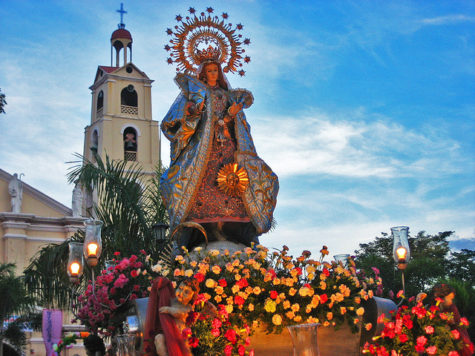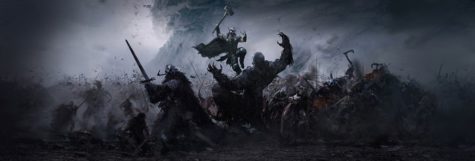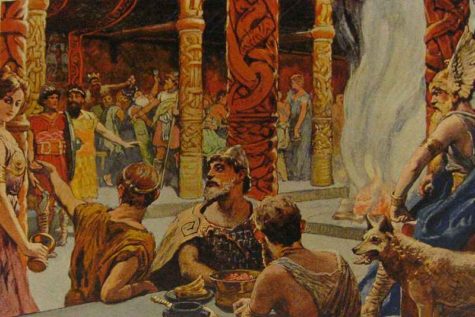Daily Archives: May 30, 2017
Flores de Mayo (Spanish for “flowers of May”) is a festival held in the Philippines in the month of May. It is one of the May devotions to the Blessed Virgin Mary and lasts for the entire month.
The Santacruzan (from the Spanish santa cruz, “holy cross”) is the ritual pageant held on the last day of the Flores de Mayo. It honors the finding of the True Cross by Helena of Constantinople (known as Reyna Elena) and Constantine the Great. Its connection with May stems from the old May 3 date of Roodmas, which Pope John XXIII abolished in 1960 in favour of the Feast of the Exaltation of the Cross on September 14
Regional Celebrations:
- In the Bicol Region, the ritual begins with the recitation of the rosary, and the last day is simply called the “katapusan”.
- In Western Visayas, the towns have their respective chapels where an image of the Virgin Mary is venerated and children gather to have a simple catechism and teachings about the life and story of Mary. They were also taught some prayers and songs recited only during the Flores de Mayo and the children offer flowers before the image of the Virgin Mary as a symbol of love, affection and veneration.
- Some churches and areas give children paper tickets for actively participating during the catechism and at the end of the month of May, the children redeem the value of the tickets which are school supplies ready for the school opening in June. Santacrusan is usually held during the last few days of May to coincide with the end of the catechism for children.
- Amongst the Tagalog people, the custom began after the publication of Mariano Sevilla’s translation of the devotional “Flores de María” or “Beautiful Flowers that in the Meditations in the Whole Month of May are Offered by Devotees to Mary Most Holy.”
- One famous May tradition in Batangas is the Luglugan, or nightly devotion and party honoring the Virgin Mary. Held in structures called tuklóng, devotees offer flowers and prayers to an image of Mary every night. After the prayer, the Hermanos or Hermanas for the day will give away treats to the participants, followed by the party. The Luglugan lasts for a month until the Tapusan (“ending”) which is marked with a Mass, a Santacruzan and procession of the Blessed Virgin Mary, and capped with a final Luglugan that lasts until the following morning.
- A Santacruzan is a religio-historical beauty pageant held in many cities, towns, and even in small communities throughout the Philippines during the month of May.
The Santacruzan Procession and Pageant
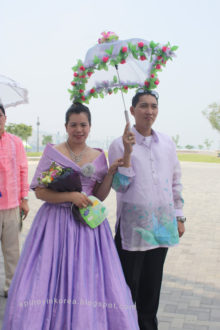 One of the most colorful aspects of this festival, the pageant depicts the finding of the True Cross by Queen Helena, mother of Constantine the Great. Many movie and television personalities participate in the events and are featured in major santacruzan. This festival became part of Filipino traditions identified with youth, love, and romance.
One of the most colorful aspects of this festival, the pageant depicts the finding of the True Cross by Queen Helena, mother of Constantine the Great. Many movie and television personalities participate in the events and are featured in major santacruzan. This festival became part of Filipino traditions identified with youth, love, and romance.
Prior to the Santacruzan, a novena is held in honor of the Holy Cross. The procession itself commemorates the search of the Holy Cross by Reyna Elena and her son, Emperor Constantine. It is said to have roots in the joyous thanksgiving celebrations that followed the finding of the Holy Cross in Jerusalem and its translation to Constantinople (now İstanbul).
The procession is accompanied by the steady beat of a local brass band, playing and singing the Dios te salve (the Spanish version of the Hail Mary). Devotees hold lighted candles and sing the prayer as they walk. It is customary for males participating in the Santacruzan to wear the traditional Barong Tagalog and that the females wear any Filipiniana-inspired dress.
After the procession in some places, there is the pabítin game (in Cavite, it is called “agaw-bitin”) that serves as a culminating activity for the children. The pabítin is a square-shaped bamboo grille or frame to which goodies (candies, fruits, small trinkets, etc.) are tied with thin strings.
This grille in turn is tied to a long rope passed over a strong branch or pole some 2 metres above the ground. Children then gather under the frame as the it is slowly lowered, and they then jump as high as they could to grab the goodies while someone jerks it up and down repeatedly until all the prizes are gone.
Sometimes the palosebo (the local version of the greasy pole) is also played, where a tall bamboo pole is smeared with grease which participants must climb to get a small red banner or a bag with a prize, such as ₱500 or a higher amount.
For a Magickal Flores de Mayo
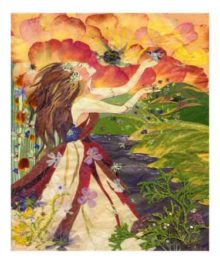 From 360 Goddess, we have a different version of, and way to celebrate the Flores de Mayo. This can be celebrated any time during the month of May, or on the last day, as a sort of magickal Santacruzan.
From 360 Goddess, we have a different version of, and way to celebrate the Flores de Mayo. This can be celebrated any time during the month of May, or on the last day, as a sort of magickal Santacruzan.
- Themes: Offering; Prayer; Love; Devotion; Home; Relationships
- Symbols: Spring; May Blossoming Flowers
- Presiding Goddess: Sisina
About Sisina:
This Filipino goddess oversees the realms of orderliness, beauty, and love. Traditionally, she protects marriages against discord, but she may also be called upon to settle inner turmoil within your soul and restore self-love.
To do today:
People in the Philippines say good-bye to May with bouquets, flower offerings, and an array of sweet foods to honor the month’s sweetness and beauty. Sometimes they ask Sisina to join the festivities by setting a place for her at the table.
This particular custom appears in several other cultures and it is a simple, lovely way of honoring the goddess. Just leave a plate with a fresh flower on your dinner table. This draws Sisina’s presence, love, and peaceful nature to your home and family relationships. If you wish, also leave an offering of sweet bread or fruity wine in a special spot to thank her.
As you go about your normal routine today, take time to enjoy any flowers you see, and be very considerate of the special people in your life. Sisina will see the effort and continue blessing those relationships with harmony.
Sources: 365 Goddess and wikipedia
Memorial Day is the day meant to be set aside to specifically honor the war dead. As such, it is an appropriate day to observe rituals to honor the Einherjar: the battle-slain warriors who are taken to Valhalla.
Who are the Einherjar? They are an army of all men who fall in battle, they are adopted as Odin’s sons. He allots to them the halls Valhalla and Vingólf. There they await Ragnarok, when they will join the Gods in fighting the Giants. They spend most of their time fighting, eating, and drinking.
Of course, not all of the battle-slain go to Valhalla some also go to Freya’s Hall, but many modern pagans will honor the war-dead, especially their ancestors who served at this time.
Others will honor the Einherjar on Veteran’s Day instead, even though, technically Veteran’s Day is intended to first and foremost honor those living Veterans from past military service, it is also used to honor those currently serving, and to a lesser degree those soldiers now dead.
For more about the Einherjar – read on…
In Norse mythology, the Einherjar (Old Norse “lone fighters”) are those that have died in battle and are brought to Valhalla by Valkyries. In Valhalla, the Einherjar eat their fill of the nightly-resurrecting beast Sæhrímnir, and are brought their fill of mead (from the udder of the goat Heiðrún) by Valkyries. The Einherjar prepare daily for the events of Ragnarök, when they will advance for an immense battle at the field of Vígríðr.
“Valholl is widely spread out;
here Odin chooses every day
weapon-slain warriors…”
In Norse cosmology, those that die in battle hold a special role within Asatru. They are the Einherjar, those that are chosen by Odin to fight on the side of the Gods at Ragnorak. (see explanation below)
Accounts of Valhalla describe it as a large hall, decked with the implements of battle. The Einherjar are described as being well-hosted, they are fed on pork and mead, and each day, the Einherjar practice at the art of battle. They engage one another in terrible, bloody conflicts, and at the end of the day, come back to life, and walk off the field, the best of friends.
All the Einheriar fight in Odin’s courts every day;
they choose the slain and ride from battle;
then they sit more at peace together.
It seems probable that historically, the Einherjar could be best described as some sort of “elite” troops, and that going to Valhalla was not necessarily the fate of the common soldier. Odin was traditionally followed by members of the ruling classes, not by ordinary folk. Adding to this the idea of the Einherjar fighting day after day, and enjoying it immensely does seem more in line with an elite unit, it seems likely that an ordinary draftee might get a little tired of day after day of fighting.
In actual modern-day practice, Einherjar blot has tended to become a day to honor all of those who die in wars, and to a lesser extent, veterans in general. How exactly does one reconcile these two different images of the Einherjar? One thing is clear, it was never a part of old Norse thought to hold to one view of the afterlife. Where you ended up after your death seemed reliant on which Gods you followed in life, and what sort of person you were.
Hail those that serve!
Hail the fallen!
Hail the Einherjar!
Note:
In Norse mythology, Ragnarök (Old Norse “final destiny of the gods”) is a series of future events, including a great battle foretold to ultimately result in the death of a number of major figures (including the gods Odin, Thor, Týr, Freyr, Heimdall, and Loki), the occurrence of various natural disasters, and the subsequent submersion of the world in water.
Afterward, the world will resurface anew and fertile, the surviving and reborn gods will meet, and the world will be repopulated by two human survivors.
Sources: Wikipedia and Raven Kindred
